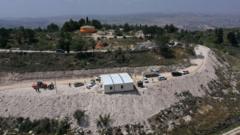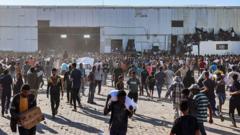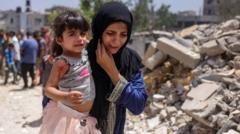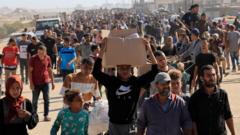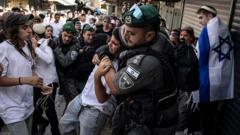A controversial aid distribution initiative by the Gaza Humanitarian Foundation faced chaos as thousands of Gazans rushed to a site in Rafah for food. The Israeli military fired warning shots amid rising tensions, raising concerns about accessibility, safety, and the implications of bypassing traditional humanitarian practices.
Chaos Erupts at Food Distribution Site Amid Controversial Aid Efforts in Gaza
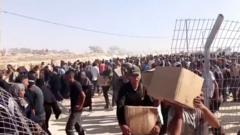
Chaos Erupts at Food Distribution Site Amid Controversial Aid Efforts in Gaza
Thousands of Palestinians flock to a US-backed aid distribution point in Gaza, leading to chaos and warnings from Israeli troops as humanitarian needs soar.
In the aftermath of the easing of a lengthy Israeli blockade, a food distribution site run by the Gaza Humanitarian Foundation (GHF) became the center of chaos as thousands of Gazans stampeded toward aid on Tuesday. The GHF, backed by the US and Israel, aims to bypass the United Nations and other humanitarian entities, stirring significant controversy over its operational methods.
Videos shared on social media highlighted the desperation among the Palestinian populace, with scenes of individuals trampling barriers in a frenzy to secure resources. The confusion at the GHF compound in Rafah led the organization’s team to retreat temporarily as they attempted to manage the overwhelming crowds seeking assistance.
Reports indicated that at one point, the situation escalated, prompting Israeli troops stationed nearby to fire warning shots to maintain control, although the Israel Defense Forces (IDF) stated that danger to personnel was not an issue. Witness accounts detailed how the strict limits on access—only allowing 50 individuals through at a time—ultimately resulted in chaos rather than an orderly distribution of aid.
Several eyewitnesses expressed their anguish over the dire circumstances, highlighting how hunger and desperation have led families to undertake perilous actions just to feed their children. One individual recounted feelings of humiliation and helplessness, lamenting the extreme scarcity of basic food staples.
The GHF has made clear that it recognizes the critical needs on the ground, having dispersed around 8,000 food parcels; however, locals experienced significant delays in accessing aid due to blockades allegedly enforced by Hamas. The GHF maintains that its distribution strategies are essential, especially given Israel's claims that Hamas is actively stealing aid.
Complicating matters, the UN has criticized GHF's approach and refused to collaborate, arguing that it undermines key humanitarian tenets. A UN spokesperson called the images from Gaza "heartbreaking" and reaffirmed the need for a principled aid delivery framework.
The dynamics of aid in Gaza continue to evolve amid military operations, hostilities, and escalating humanitarian crises. The GHF has publicly asserted its aim to distribute food to one million Gazans this week, but fears persist regarding the broader implications of its plans on humanitarian principles, as well as the necessity of meeting the immediate needs of the civilian population amid ongoing conflict.
As the international community observes this unfolding situation, discussions surrounding the nature of legitimate humanitarian aid and the protection of civilians remain paramount.
Videos shared on social media highlighted the desperation among the Palestinian populace, with scenes of individuals trampling barriers in a frenzy to secure resources. The confusion at the GHF compound in Rafah led the organization’s team to retreat temporarily as they attempted to manage the overwhelming crowds seeking assistance.
Reports indicated that at one point, the situation escalated, prompting Israeli troops stationed nearby to fire warning shots to maintain control, although the Israel Defense Forces (IDF) stated that danger to personnel was not an issue. Witness accounts detailed how the strict limits on access—only allowing 50 individuals through at a time—ultimately resulted in chaos rather than an orderly distribution of aid.
Several eyewitnesses expressed their anguish over the dire circumstances, highlighting how hunger and desperation have led families to undertake perilous actions just to feed their children. One individual recounted feelings of humiliation and helplessness, lamenting the extreme scarcity of basic food staples.
The GHF has made clear that it recognizes the critical needs on the ground, having dispersed around 8,000 food parcels; however, locals experienced significant delays in accessing aid due to blockades allegedly enforced by Hamas. The GHF maintains that its distribution strategies are essential, especially given Israel's claims that Hamas is actively stealing aid.
Complicating matters, the UN has criticized GHF's approach and refused to collaborate, arguing that it undermines key humanitarian tenets. A UN spokesperson called the images from Gaza "heartbreaking" and reaffirmed the need for a principled aid delivery framework.
The dynamics of aid in Gaza continue to evolve amid military operations, hostilities, and escalating humanitarian crises. The GHF has publicly asserted its aim to distribute food to one million Gazans this week, but fears persist regarding the broader implications of its plans on humanitarian principles, as well as the necessity of meeting the immediate needs of the civilian population amid ongoing conflict.
As the international community observes this unfolding situation, discussions surrounding the nature of legitimate humanitarian aid and the protection of civilians remain paramount.



